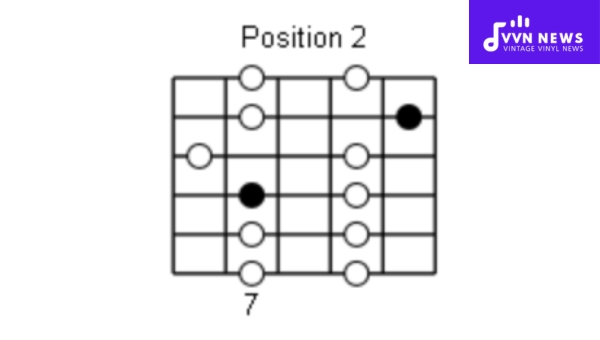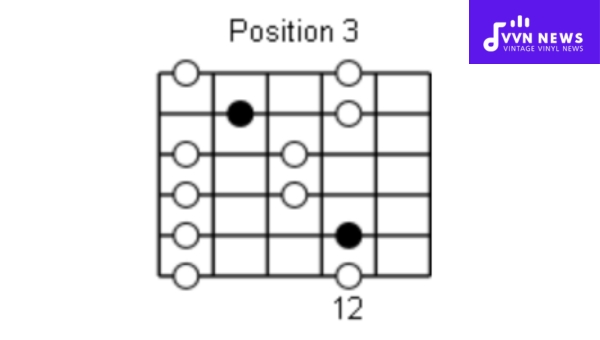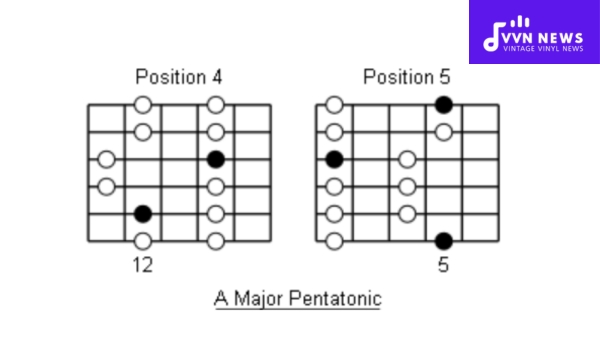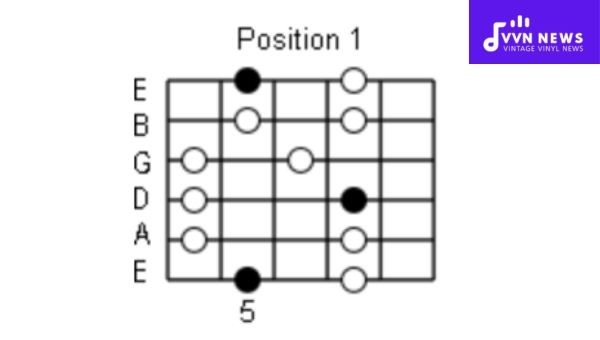If you’ve ever found yourself tapping your foot to the melodic strumming of a guitar solo or nodding along to a catchy blues riff, chances are you’ve encountered the charms of a major pentatonic scale.
This five-note musical wonder is a staple for musicians across genres, from rock to country, and for good reason.
It’s not only versatile but also incredibly user-friendly for beginners trying to master the art of melody.
The major pentatonic scale can open up a world of creative expression for any aspiring player.
At its core, it’s about simplicity and elegance — shaping tunes that sound familiar yet fresh to the ears.
Whether you’re looking to improvise effortlessly over chord changes or craft a memorable solo that resonates with listeners, getting to grips with this scale will serve as your foundation in the fascinating realm of music theory.
What Defines the A Major Pentatonic Scale?
The A Major Pentatonic Scale is a five-note musical sequence that encompasses the first, second, third, fifth, and sixth degrees of the A Major scale.
The notes in this scale – A, B, C#, E, and F# – combine to create a bright and uplifting sound.
This particular pentatonic scale omits the fourth and seventh scale degrees which are known to introduce tension, offering instead a more consonant and pleasant sonic experience.
Given its construction, it favors clear and melodious lines that can seamlessly meld into various musical contexts, providing a platform for both melodic exploration and dynamic improvisation.
How do you build the A Major Pentatonic Scale?
The beauty of constructing the A Major Pentatonic Scale lies in its simplicity.

Begin with the root note, A. Next, skip the B note to land on the major second, C#.
Move a whole step forward to hit the major third, E. From here, jump over the F# to greet the perfect fifth, which is A again (one octave higher).
Leapfrog past G# to arrive at your major sixth, B. Here’s the sequence in the notes:
- A (Root)
- C# (Major Second)
- E (Major Third)
- A (Perfect Fifth – One Octave Higher)
- B (Major Sixth)
Memorize this pattern: Root – Major Second – Major Third – Perfect Fifth – Major Sixth.
Each interval from one note to its successor defines how this enchanting scale takes shape.
Use this structure as your template for melodic exploration and improvisation with finesse.
Also Read: F Minor Scale Explained [Step-By-Step Guide To Mastering Scales]
What are the 5 patterns of A Major Pentatonic Scale?
When embarking on your musical journey, suddenly crossing paths with different patterns and scales can seem daunting.
Fear not—once you delve into mastering the intricate details provided here, you’ll find that it’s like learning a new language, only more melodious!
Pattern 1
Let’s begin with the root pattern—the pattern that starts on the root note of the scale.
Given we’re discussing the A Major Pentatonic scale, this implies the root note (first note) is an A.
Commence playing on the 5th fret of your low E string (this is your A note), then move along to the 7th fret (B), shifting onto next string—A string—play frets 4 (C#) and 7(E).
The sequence continues on D and G strings both utilizing frets 4(F#) and 7(A).
Finalize upon B string playing frets 5(C#) and 7(E), lastly stamping out on E string with frets 5(F#) and E(A).
Pattern 2
Evolving from the root pattern, let’s move on to Pattern Two of the A Major Pentatonic.
This pattern initiates from our second degree or note in this case B.
Start off at the low E string but now on the 7th fret (B), play also the ninth fret (C#); hop onto the A string and play the same combination as above but now they represent different notes; D & E respectively.
This procedure remains identical for D & G strings too but births notes F# & A.
Transition to B String opting for familiar methodology bestowing us C# & E all leading towards climaxing high upon E String serenading us with F# & A.
Pattern Three
Shifting forward, we’re onto Pattern Three. This pattern embarks from the third degree—C#.
Open your act upon the 9th fret of E string (C#) and then onto fret 11(D), manage your route towards A string, and play frets 7(E) & 9(F#).
The pattern is maintained upon D string which now personifies G# & B notes.
Unveil your next sequence resting on G string playing the same frets but they incarnate C# & E notes this time.
Subsequent shift onto the B string and reproduce sounds of F# & A with similar fret positions.
Bid adieu on the high E at the ninth (G#) and eleventh (A) fret for a perfect resolution to Pattern Three.
Also Read: B Flat Minor Scale Explained [Learn And Experiment With Scales]
Pattern Four
Progressing now to Pattern Four which commences on our fourth degree—D(E).
Launch on low E at the twelfth fret portraying a D, moving ahead on the fourteenth represents an E; Assimilate theme whilst transitioning strings mirroring the twelfth & fourteenth respectively delineating: F# & G#; A, B; C#,D; E,F#.
Pattern Five
The last island is reached— Pattern Five claiming origin from F sharp appearing as a fifth degree.
Start grandly from F sharp found in the fourteenth fret of low E string then proceed to reach its neighbor; G sharp utilizing the sixteenth fret.
Gradually glide onto the next array of strings, however keep consistent with identical pattern bestowing corresponding degrees each conveying distinct notes due to transposition caused by shifting base(C#, D; E, F#, G#, A, B, C#, D, E).
It’s essential to perceive these patterns as interconnected links forming a cohesive chain rather than separate entities, once you do, navigating your musical torrent becomes much more instinctive and enjoyable!
How do major and minor pentatonic relate?
In music theory, relative scales share the same notes but are centered on different root notes.

For instance, the A Major Pentatonic Scale and its relative minor, F# Minor Pentatonic Scale, consist of identical pitches. Here is a quick breakdown of how they correlate:
- A Major Pentatonic: A – B – C# – E – F#
- F# Minor Pentatonic: F# – A – B – C# – E
Notice that the F# Minor starts on F#, which is a minor third below A—the major scale’s root.
By beginning on the sixth degree (F# in this case) of a major pentatonic scale, you effectively play its relative minor pentatonic.
This interrelation allows for seamless modal transitions and broadens your improvisational palette when crafting melodies across various musical atmospheres.
Also Read: G Major Scales And Chords [Expand Your Musical Understandings]
Why Use Backing Tracks for A Major Pentatonic Scale Practice?
When you’re honing your skills on the guitar, practicing scales can sometimes feel a bit tedious.
But incorporating backing tracks into your routine can transform a dry exercise into an engaging musical experience.
Here are five compelling reasons to use backing tracks when practicing the A Major Pentatonic Scale.
Enhancement of Musical Context
Firstly, practicing with backing tracks allows you to hear the scale within the context of proper harmony and rhythm.
It showcases how the notes you’re playing fit into a groove or chord progression.
Practicing scales in isolation can cause disconnection from real-world application, but a backing track underscores where each tone of your A Major Pentatonic might land in an actual song.
Better Rhythmic Feel
Utilizing backing tracks inherently improves your timing and sense of rhythm.
Maintaining synchronization with the steady pulse provided by a drumbeat or other rhythmic element sharpens your internal metronome.
Consequently, this solidifies your ability to lock-in with other musicians during jam sessions or performances.
Creativity and Improvisation
Employing a backing track elevates practice from mere repetition to an exercise in creative improvisation.
It compels you to devise licks, melodies, and riffs on the fly within the scale framework—a critical skill for any improvising musician.
With various backing tracks, you can explore different styles and tempos, keeping your practice sessions vibrant and diverse.
Build Real-Life Performance Skills
Engaging with backing tracks is akin to playing alongside other band members—it simulates a live performance environment.
You learn how to weave your scale playing into existing musical landscapes and react dynamically to changes just as you would on stage.
Encourages Ear Training
Integrating aural skills becomes imperative when practicing with accompaniment—it’s no longer just about reading tabs or scores.
Picking out chord changes and identifying intervals against background music fine-tunes your ear, allowing for more melodious improvisation that communicates effectively with underlying harmonies.
Incorporating these elements into your daily practice will not only enhance technical proficiency but also equip you with practical musicianship that resonates beyond solitary practice sessions.
Also Read: D Major: The Scales And Chords [Broaden Your Musical Vocabulary]
Songs Highlighting the Major Pentatonic Scale
The major pentatonic scale’s delightfully catchy and uplifting sound is showcased across an array of iconic tracks.

Here’s a closer look at five songs that not only harness its power but also remain etched in our musical landscape:
“My Girl” by The Temptations
The use of the C major pentatonic scale underscores the classic bassline and melody in The Temptation’s “My Girl.”
This enchanting tune leans heavily on the sweetness of the pentatonic to accentuate its optimistic vibes.
It’s a quintessential example of how fewer notes can speak volumes in crafting a memorable hook that stands the test of time.
“Sweet Home Alabama” by Lynyrd Skynyrd
Lynyrd Skynyrd’s southern rock anthem relies on a G major pentatonic scale, executed with finesse.
Listen closely to the unmistakable guitar riff, you’ll notice the distinct pattern of notes aligns perfectly with those within this scale, illustrating its effectiveness in driving rhythm alongside melody.
“Brown Eyed Girl” by Van Morrison
In Van Morrison’s joyful tune, G major pentatonic comes into play yet again.
The jubilant introductory lick and solos between verses demonstrate how this simple scale structure creates a sound that is both harmonious and instantly recognizable—truly capturing the song’s sunny disposition.
“Stairway to Heaven” by Led Zeppelin
Led Zeppelin bends genres using an A minor pentatonic which relates closely to its major counterpart due to relative scales sharing identical notes.
The famed solo by Jimmy Page showcases these notes building intensity that seamlessly transitions between feelings of mystery and revelation—a testament to its versatility.
“Cinnamon Girl” by Neil Young
Neil Young employs an E major pentatonic scale through his one-note solo in “Cinnamon Girl,” proving simplicity can yield an impactful sonic experience.
This approach cuts through the mix and adds a layer of raw energy reflective of Young’s signature style.
These songs exemplify just how integral the major pentatonic scale is within various musical contexts, demonstrating its ability to evoke emotion whilst maintaining simplicity.
Musicians often revisit these tracks when seeking inspiration for crafting timeless melodies because they embody what it means to harness five notes into something truly extraordinary.
Also Read: Enharmonic Equivalent Notes And Scales [Master Music Theory]
FAQs about the A Major Pentatonic Scale
What notes make up the A Major Pentatonic Scale?
The A Major Pentatonic Scale consists of the notes A, B, C#, E, and F#.
Can I play the A Major Pentatonic Scale over any chord progression?
Yes, you can! However, it sounds best when played over chord progressions in the key of A major or with chords derived from this scale.
Is the A Major Pentatonic Scale suitable for beginners?
Absolutely, its pattern is relatively easy to learn and a great starting point for beginners looking to delve into lead guitar playing.
Do I need to learn all 5 patterns of the A Major Pentatonic Scale right away?
Not necessarily. Start with one pattern and get comfortable before moving on to explore additional patterns.
Where can I find backing tracks for practicing the A Major Pentatonic Scale?
You can find numerous resources online with free backing tracks; websites like YouTube are a treasure trove for such materials.
Conclusion
In wrapping up, the A Major Pentatonic Scale is a magnificent tool for any musician looking to enrich their melody-making prowess.
With its five pristine notes, it offers a roadmap to effortless improvisation and tuneful expressions that can elevate your music.
Practicing the scale in various patterns ensures versatility and familiarity across the fretboard.
Utilize backing tracks to refine your skills and bring your appreciating full circle.
The journey through the major pentatonic is fulfilling — an essential passage for every melodious quest in music creation.
Explore, experience, and let your melodies soar with this timeless scale.








